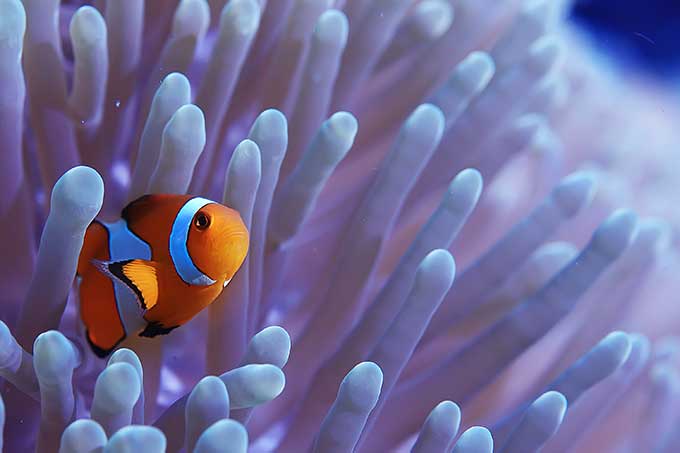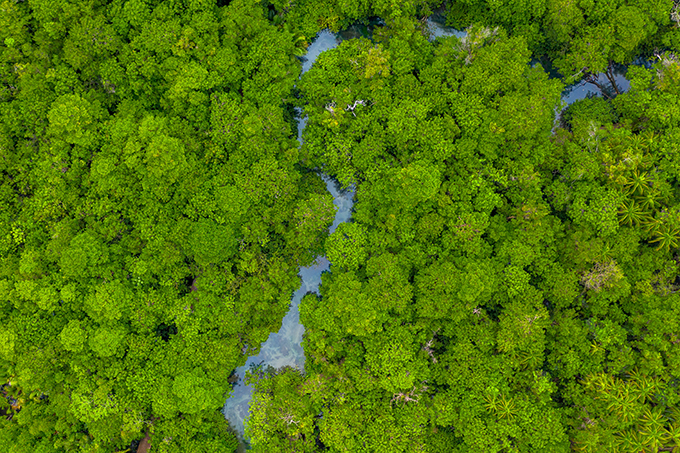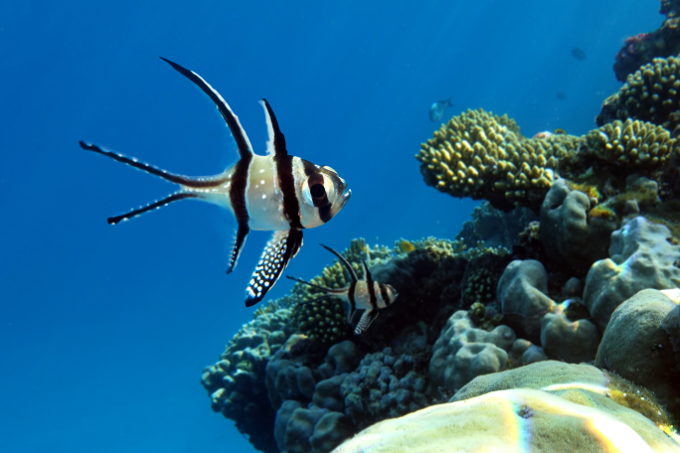Oceans and coasts - Fascinating biodiversity
Vulnerable and vital to life on Earth
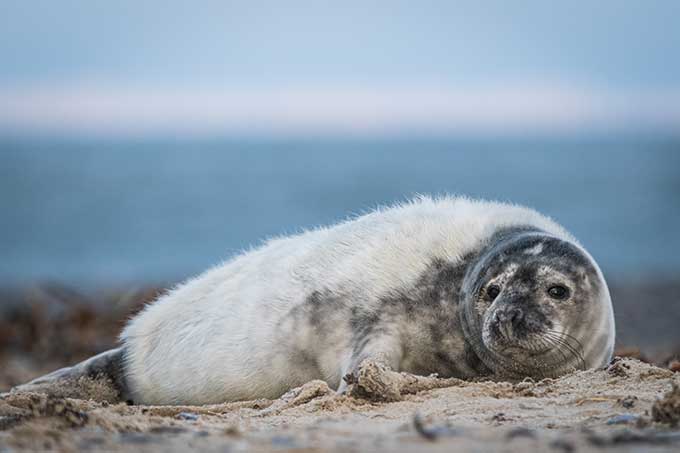
A grey seal rests on a beach - photo: Marc Scharping
Oceans cover more than 70 percent of the earth’s surface, represent about 95 percent of the living biosphere and contain 97 percent of all water on our planet. Life on earth would be unthinkable without the complex interplay of currents and cycles, large bodies of water and interactions with the atmosphere.
The oceans have a global influence on climate and weather and provide a wide variety of species-rich habitats worldwide, which in turn are the source of life for every living organism in water and on land. Only intact and diverse seas are able to maintain the impressive ecosystem services and their stabilizing effects on the climate. But many ecosystem services and interactions with other ecosystems, including currents, water temperature and precipitation, are strongly connected to the global climate. According to the report of the World Biodiversity Council, the mean temperature will rise further due to climate change, and ecological tipping points will be reached. Passing the tipping points will disrupt the fragile interplay of ecosystems and lead to irreversible changes, which will damage or destroy habitats and endanger species.
"Marine and coastal ecosystems are among the most vulnerable ecosystems on earth and more than a billion people are directly dependant on the ecosystem services they provide."
Svane Bender, NABU Deputy Director International Affairs / Head of Africa Programme
Biodiversity of our marine ecosystems
There are diverse and unique ecosystems in our oceans, but probably the most striking are the colourful coral reefs of the tropics. Coral reefs are by far the most species-rich and productive marine formations. They are home to about a quarter of all marine animals and plants and are among the oldest ecosystems on earth. In coral reefs, permanent reef dwellers such as the clownfish and the reef shark share the habitat with species of the open ocean, which are searching for food or breeding sites. Every part of a healthy reef is inhabited: sea urchins and mussels can be found in the gaps between the corals; moray eels, octopuses and shy fish species inhabit the reef caves; turtles rest at the dazzling underwater oases on their migrations through the ocean. But the heart of every coral reef is the coral itself.
Corals consist of marine invertebrates and symbiotic algae, which form calcareous structures. Formed over centuries, these provide the structure for coral reefs worldwide. But the slow growth of corals, combined with their high habitat requirements, makes the system particularly vulnerable to change. Corals are highly sensitive to increasing water temperatures due to climate change. Once the water temperature rises just slightly, the symbiotic algae leave the polyps. The polyps themselves are colourless and the coral appears bright white. This state is known as coral bleaching. If the temperatures stay continuously high, the coral polyps die, are overgrown by algae and leave behind bare, colourless calcareous skeletons.
Besides coral reefs, mangrove forests on the coasts of tropical seas are an important refuge for many species and serve as breeding grounds and places for foraging. Numerous fish and even some shark species use the flooded root zones of mangrove forests to raise their young. Mudskippers and crabs live in the muddy fringes, and numerous birds forage here. The treetops of the mangrove forests serve as nesting sites for seabirds; monkeys and reptiles use the mangrove forests as a refuge. The Sundurbans, a huge mangrove forest on the Bay of Bengal, is home to the largest tiger population in Bangladesh. These ecosystems are also endangered by human activities. The forests are cleared to develop areas with wide white-sand beaches for tourism, and accidents at oil production facilities cause lasting damage to mangrove forests.
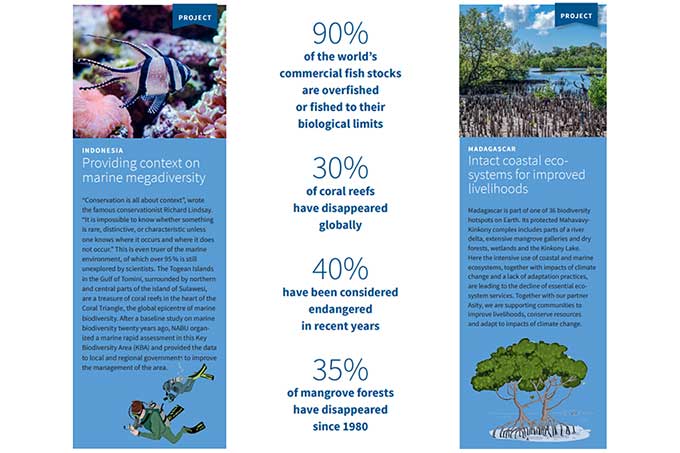
NABU implements projects to protect marine and coastal ecosystems around the world - photos: hunterkitty/ stock.adobe.com, Álvarez & Riziky/ stock.adobe.com, Julia Friese
Marine ecosystems under threat
Tropical coral reefs are particularly at risk from climate change and rising average temperatures. NABU has discovered the seriousness of the damage through a study in the Western Pacific Coral Triangle, around the Togean Islands. One of the most species-rich reef formations in the world, it is heavily damaged and its functionality is impaired. The survey confirmed that most fish populations are overfished and reefs have been damaged by dynamite fishing. NABU has also been able to show that large parts of the coral reef are massively affected by coral bleaching. This is not surprising: for several months in 2015, the El Niño effect (a significant warming of the water in the tropical East Pacific, triggered by climate change) caused critical temperatures of over 33° C in the region. El Niño has led to massive coral mortality in Australia’s Great Barrier Reef, and the results of the survey show that many of the Indonesian coral reefs have been affected as well.
All marine ecosystems are interconnected, and the interactions with terrestrial ecosystems are also essential. For many inhabitants of the coral reef, such as fish and crustaceans, neighbouring mangrove forests are used as breeding grounds for their young. Likewise, animals of the open ocean come to the reefs and mangroves to find shelter to safely rear their offspring. This proves that the persistence of individual ecosystems keeps the whole ocean functioning.
Protecting mangroves for healthier ecosystems
There are also important links between the protection of rain and mangrove forests and the protection of the reefs. If the forest disappears, the underlying soil is exposed to erosion, and after rainfall rivers deposit large amounts of sediment on the offshore reefs. Organic material that enters the sea through erosion deprives the water of oxygen and lowers the pH value, to which the corals are very sensitive. There is a risk of the reef dying if too much sediment is washed in. Intensive exploitation of fragile coastal and marine ecosystems is leading to severe degradation, erosion and the decline of ecosystem services that are vital for the region’s inhabitants.
In Madagascar, NABU and its partner ASITY Madagascar have supported the transition of the unique coastal mangrove estuary complex Mahavavy-Kinkony into a community-managed protected area. The coastal ecosystems’ flora and fauna are regularly monitored to detect changes and threats. In partnership with coastal user communities, the coasts are being monitored to reduce illegal fisheries and marine extraction, and a sustainable fisheries management concept is being established in collaboration with the local authorities. Alternative income measures, particularly for women, are helping to reduce pressure on exploited coastal ecosystems, while farmers are being trained to adapt their land use to climate change.
Fishing for litter - cleaning our oceans
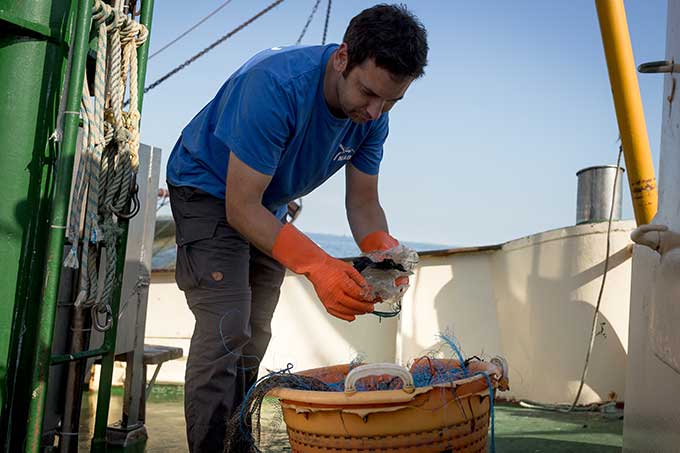
Together with fishermen and volunteers, NABU fights against marine litter in the North and Baltic Sea - photo: NABU/ Philip Scholl
It is not only coral reefs and mangrove forests that need protection, however. Another major problem is the pollution of coasts and seas by plastic waste. More than ten million tonnes of waste enter the oceans every year. Animals feed on this plastic or become entangled in ‘ghost nets’; thousands of animals die in this way every year. The residual plastic is gradually crushed by the tides in the sea and eventually enters the food chain as microscopic plastic.
NABU is tackling this problem with a trial project (German-language NABU page). The idea is as simple as it is effective. German coastal fishermen in the North and Baltic Sea catch considerable amounts of waste in their nets every day. Often this is simply thrown back into the sea; so far there has been no regulated and environmentally friendly waste disposal system. NABU is therefore developing effective disposal structures for the “fished” waste in numerous ports.
The fishermen collect rubbish in large bags, which are provided for free, and bring it to containers at the port. Afterwards, the waste is sorted and documented by NABU volunteers, to collect important information on the composition and origin of the waste. Once the waste has been disposed of properly, NABU uses the data for studies to build pressure on politicians and decision-makers.
SELECTED PROJECTS
The protected area Mahavavy-Kinkony in Madagascar suffers from degradation of its coastal ecosystems. NABU and ASITY Madagascar joined forces supporting communities for restoring ecosystems, improving livelihoods and responding to the impacts of climate change. more →
The marine biodiversity of the Coral Triangle is threatened by overfishing and habitat degradation. We support coastal communities of the Banggai Islands to secure their livelihoods through sustainable fishing practices in line with the Marine Protected Area. more →
Mangroves and their ecosystem services are indispensable for Indonesia's coastal communities. However, the country experiences alarming rates of mangrove loss. In Sulawesi, we support mangrove conservation and identify areas suitable for restoration. more →
Salt, honey, mangrove conservation: NABU and SOS-Forêts are promoting sustainable sources of income for women in the area surrounding Azagny National Park, such as natural salt production and beekeeping. The focus is on nature conservation. more →

